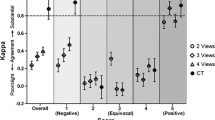Abstract
Purpose
Magnetic resonance imaging (MRI) is often used in the evaluation of lower back pain in adolescents. The purpose of our study is to report on the frequency of MRI missing spondylolysis in adolescents with back pain in a pediatric orthopaedic practice.
Methods
A retrospective review of all patients with a diagnosis of spondylolysis who presented from January 2000 to March 2010 was performed. All patients were evaluated at a single institution by the senior author. Inclusion criteria were patients with spondylolysis confirmed on computed tomography (CT) or plain film that also received an MRI.
Results
Eleven patients with spondylolysis had an MRI performed. The mean age of the study patients was 14.2 years (range 10–17). The diagnosis of spondylolysis was missed in the MRI radiology reading in 7 out of 11 (64 %) studies.
Conclusions
MRI missed a spondylolysis in over half of the adolescents in this consecutive series. In patients with a history or physical findings suggestive of spondylolysis, such as localized pain of the lumbar spine with back extension, further radiographic evaluation should be considered, even if an MRI is negative.
Level of evidence
III, retrospective review.

Similar content being viewed by others
References
Burton AK, Clarke RD, McClune TD, Tillotson KM (1996) The natural history of low back pain in adolescents. Spine (Phila Pa 1976) 21(20):2323–2328
Skaggs DL, Early SD, D’Ambra P, Tolo VT, Kay RM (2006) Back pain and backpacks in school children. J Pediatr Orthop 26(3):358–363. doi:10.1097/01.bpo.0000217723.14631.6e
Faingold R, Saigal G, Azouz EM, Morales A, Albuquerque PA (2004) Imaging of low back pain in children and adolescents. Semin Ultrasound CT MR 25(6):490–505
Micheli LJ, Wood R (1995) Back pain in young athletes. Significant differences from adults in causes and patterns. Arch Pediatr Adolesc Med 149(1):15–18
Ralston S, Weir M (1998) Suspecting lumbar spondylolysis in adolescent low back pain. Clin Pediatr (Phila) 37(5):287–293
Fredrickson BE, Baker D, McHolick WJ, Yuan HA, Lubicky JP (1984) The natural history of spondylolysis and spondylolisthesis. J Bone Joint Surg Am 66(5):699–707
Logroscino G, Mazza O, Aulisa G, Pitta L, Pola E, Aulisa L (2001) Spondylolysis and spondylolisthesis in the pediatric and adolescent population. Childs Nerv Syst 17(11):644–655. doi:10.1007/s003810100495
El Rassi G, Takemitsu M, Woratanarat P, Shah SA (2005) Lumbar spondylolysis in pediatric and adolescent soccer players. Am J Sports Med 33(11):1688–1693. doi:10.1177/0363546505275645
Leone A, Cianfoni A, Cerase A, Magarelli N, Bonomo L (2011) Lumbar spondylolysis: a review. Skeletal Radiol 40(6):683–700. doi:10.1007/s00256-010-0942-0
Saifuddin A, Burnett SJ (1997) The value of lumbar spine MRI in the assessment of the pars interarticularis. Clin Radiol 52(9):666–671
Ulmer JL, Mathews VP, Elster AD, Mark LP, Daniels DL, Mueller W (1997) MR imaging of lumbar spondylolysis: the importance of ancillary observations. AJR Am J Roentgenol 169(1):233–239
Campbell RS, Grainger AJ, Hide IG, Papastefanou S, Greenough CG (2005) Juvenile spondylolysis: a comparative analysis of CT, SPECT and MRI. Skeletal Radiol 34(2):63–73. doi:10.1007/s00256-004-0878-3
Mason DE (1999) Back pain in children. Pediatr Ann 28(12):727–738
Harvey CJ, Richenberg JL, Saifuddin A, Wolman RL (1998) The radiological investigation of lumbar spondylolysis. Clin Radiol 53(10):723–728
Anderson K, Sarwark JF, Conway JJ, Logue ES, Schafer MF (2000) Quantitative assessment with SPECT imaging of stress injuries of the pars interarticularis and response to bracing. J Pediatr Orthop 20(1):28–33
Sairyo K, Sakai T, Yasui N (2009) Conservative treatment of lumbar spondylolysis in childhood and adolescence: the radiological signs which predict healing. J Bone Joint Surg Br 91(2):206–209. doi:10.1302/0301-620X.91B2.21256
McClellan JW, Ryschon K, Stamm S (2009) Healing rate for 124 adolescent lumbar pars interarticularis fractures treated conservatively. Paper presented at the Scoliosis Research Society (SRS) 44th annual meeting & course, San Antonio, TX, USA, 23–26 September 2009
Conflict of interest
None.
Author information
Authors and Affiliations
Corresponding author
About this article
Cite this article
Yamaguchi, K.T., Skaggs, D.L., Acevedo, D.C. et al. Spondylolysis is frequently missed by MRI in adolescents with back pain. J Child Orthop 6, 237–240 (2012). https://doi.org/10.1007/s11832-012-0409-z
Received:
Accepted:
Published:
Issue Date:
DOI: https://doi.org/10.1007/s11832-012-0409-z



